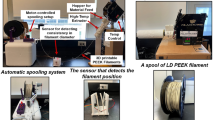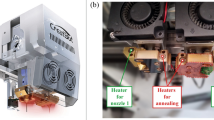Abstract
Poly-ether-ether-ketone (PEEK) has several approving mechanical properties; however, for certain demanding applications such as automotive, PEEK does not exhibit the required strength. Moreover, if the PEEK parts are developed by Fused Filament Fabrication (FFF)-based 3D Printing, there is a high chance of having PEEK parts with decreased mechanical properties. Carbon fiber (CF) reinforcement is a well-known method of mitigating the low mechanical properties of PEEK. Hence, in the present study, we attempted to develop CF-reinforced PEEK (CFR-PEEK) parts via FFF. First, we developed homogeneous CFR-PEEK mixtures via ball milling and explored the effects of different milling durations and speeds on the extent of uniform dispersion of the CFs in the PEEK matrix. Next, we fed the CFR-PEEK milled powders into a high-temperature extrusion setup to develop uniform-diameter CFR-PEEK filaments. We analyzed the effects of different extrusion parameters on the uniform-diameter CFR-PEEK filament quality to make it suitable for 3D printing. Finally, the CFR-PEEK filaments were used in a high-temperature FFF setup to develop design-specific parts. Our results indicate that 400 rpm and 4 h were apt for developing uniform CFR-PEEK mixtures. Interestingly, increasing the CF content above 10 vol% resulted in brittle filaments. The extrusion temperature, speed, and cooling rate played a major role in forming the uniform-diameter CFR-PEEK filaments. Finally, the 3D-printed CFR-PEEK parts exhibited a tensile strength of 49 MPa, lesser than unfilled PEEK. We indicate that poor interfacial bonding of the CF with the PEEK matrix is a primary reason for this reduced strength. In addition, printing defects such as pores also contributed to the reduced strength of the CFR-PEEK parts.










Similar content being viewed by others
References
Jones D, Leach D, Moore D (1985) Mechanical properties of poly (ether-ether-ketone) for engineering applications. Polymer 26(9):1385–1393
Zalaznik M, Kalin M, Novak S (2016) Influence of the processing temperature on the tribological and mechanical properties of poly-ether-ether-ketone (PEEK) polymer. Tribol Int 94:92–97
Rinaldi M et al (2018) Additive layer manufacturing of poly (ether ether ketone) via FDM. Compos B Eng 145:162–172
Goh G et al (2021) Additively manufactured continuous carbon fiber-reinforced thermoplastic for topology optimized unmanned aerial vehicle structures. Compos B Eng 216:108840
Gosselin C et al (2016) Large-scale 3D printing of ultra-high performance concrete–a new processing route for architects and builders. Mater Des 100:102–109
Fontaine D, LeBlanc J, Shukla A (2021) Blast response of carbon-fiber/epoxy laminates subjected to long-term seawater exposure at sea floor depth pressures. Compos B Eng 215:108647
Chen J et al (2012) Research on friction and wear behaviors of PEEK/PEI/PES plastics alloys under sliding contact condition. Procedia Engineering 36:285–291
Quan D et al (2020) Effect of interlaying UV-irradiated PEEK fibres on the mechanical, impact and fracture response of aerospace-grade carbon fibre/epoxy composites. Compos B Eng 191:107923
Ning F et al (2015) Additive manufacturing of carbon fiber reinforced thermoplastic composites using fused deposition modeling. Compos B Eng 80:369–378
Dai J-N et al (2022) High-content continuous carbon fibers reinforced PEEK matrix composite with ultra-high mechanical and wear performance at elevated temperature. Compos Struct 295:115837
Peng W et al (2021) Effects of FDM-3D printing parameters on mechanical properties and microstructure of CF/PEEK and GF/PEEK. Chin J Aeronaut 34(9):236–246
Wang P et al (2020) Preparation of short CF/GF reinforced PEEK composite filaments and their comprehensive properties evaluation for FDM-3D printing. Compos B Eng 198:108175
Li S et al (2013) Effect of carbon particle and carbon fiber on the microstructure and mechanical properties of short fiber reinforced reaction bonded silicon carbide composite. J Eur Ceram Soc 33(4):887–896
Luo M et al (2019) Impregnation and interlayer bonding behaviours of 3D-printed continuous carbon-fiber-reinforced poly-ether-ether-ketone composites. Compos A Appl Sci Manuf 121:130–138
Wan Y, Takahashi J (2016) Tensile and compressive properties of chopped carbon fiber tapes reinforced thermoplastics with different fiber lengths and molding pressures. Compos A Appl Sci Manuf 87:271–281
Li Y et al (2022) Bending properties, compression properties, biocompatibility and bioactivity of sulfonated carbon fibers/PEEK composites with graphene oxide coating. Appl Surf Sci 575:151774
Chen B et al (2017) Poly Aryl Ether Ketones (PAEKs) and carbon-reinforced PAEK powders for laser sintering. J Mater Sci 52(10):6004–6019
Suryanarayana C (2001) Mechanical alloying and milling. Prog Mater Sci 46(1–2):1–184
Garcia-Gonzalez D et al (2015) Investigation of mechanical impact behavior of short carbon-fiber-reinforced PEEK composites. Compos Struct 133:1116–1126
Sikder P, Challa BT, Gummadi SK (2022) A comprehensive analysis on the processing-structure-property relationships of FDM-based 3-D printed polyetheretherketone (PEEK) structures. Materialia 22:101427
Zhang G et al (2008) Tensile and tribological behaviors of PEEK/nano-SiO2 composites compounded using a ball milling technique. Compos Sci Technol 68(15–16):3073–3080
Sathishkumar S, Jawahar P, Chakraborti P (2022) Influence of carbonaceous reinforcements on mechanical and tribological properties of PEEK composites–a review. Polymer-Plastics Technol Mater 61(12):1367–1384
Jiang Z et al (2022) Thermal conductive segregated multi-scale network constructed by ball-milling and in-situ polymerization in PEEK/MWCNT/graphite composite. Compos Commun 29:101035
Hedayati M et al (2011) Ball milling preparation and characterization of poly (ether ether ketone)/surface modified silica nanocomposite. Powder Technol 207(1–3):296–303
Bokam VK et al (2023) Extrusion of uniform-diameter polyetheretherketone-magnesium phosphate bio-composite filaments for 3D printing of design-specific multi-functional implants. Materials Advances
Yang D et al (2021) Effects of crystallinity control on mechanical properties of 3D-printed short-carbon-fiber-reinforced polyether ether ketone composites. Polym Testing 97:107149
Saini A et al (2022) Fused filament fabrication-3D printing of poly-ether-ether-ketone (PEEK) spinal fusion cages. Mater Lett 328:133206
Challa BT et al (2022) In-house processing of 3D printable polyetheretherketone (PEEK) filaments and the effect of fused deposition modeling parameters on 3D-printed PEEK structures. Int J Adv Manuf Technol 121(3–4):1675–1688
Sonaye SY et al (2022) Patient-specific 3D printed Poly-ether-ether-ketone (PEEK) dental implant system. J Mech Behav Biomed Mater 136:105510
Rodzeń K et al (2021) Improvement of the layer-layer adhesion in FFF 3D printed PEEK/carbon fibre composites. Compos A Appl Sci Manuf 149:106532
Yang C et al (2017) Influence of thermal processing conditions in 3D printing on the crystallinity and mechanical properties of PEEK material. J Mater Process Technol 248:1–7
Wang P, Zou B, Ding S (2019) Modeling of surface roughness based on heat transfer considering diffusion among deposition filaments for FDM 3D printing heat-resistant resin. Appl Therm Eng 161:114064
Elhattab K, Bhaduri SB, Sikder P (2022) Influence of fused deposition modelling nozzle temperature on the rheology and mechanical properties of 3D printed β-tricalcium phosphate (TCP)/polylactic acid (PLA) composite. Polymers 14(6):1222
Gummadi SK et al (2022) Mechanical properties of 3D-printed porous poly-ether-ether-ketone (PEEK) orthopedic scaffolds. JOM 74(9):3379–3391
Yan M et al (2018) High temperature rheological behavior and sintering kinetics of CF/PEEK composites during selective laser sintering. Compos Sci Technol 165:140–147
Funding
This work was supported by Dr. Sikder’s STARTUP grant at Cleveland State University.
Author information
Authors and Affiliations
Contributions
All authors contributed to the study’s conception and design. Material preparation, data collection, and analysis were performed by Harsha P. S. Naganaboyina, Phaniteja Nagaraju, Surendrasingh Y. Sonaye, and Vijay K. Bokam. The first draft of the manuscript was written by Prabaha Sikder. All authors commented on previous versions of the manuscript. All authors read and approved the final manuscript.
Corresponding author
Ethics declarations
Competing interest
The authors declare no conflict of interest.
Additional information
Publisher's Note
Springer Nature remains neutral with regard to jurisdictional claims in published maps and institutional affiliations.
Rights and permissions
Springer Nature or its licensor (e.g. a society or other partner) holds exclusive rights to this article under a publishing agreement with the author(s) or other rightsholder(s); author self-archiving of the accepted manuscript version of this article is solely governed by the terms of such publishing agreement and applicable law.
About this article
Cite this article
Naganaboyina, H.P.S., Nagaraju, P., Sonaye, S.Y. et al. In-house processing of carbon fiber-reinforced polyetheretherketone (CFR-PEEK) 3D printable filaments and fused filament fabrication-3D printing of CFR-PEEK parts. Int J Adv Manuf Technol 128, 5011–5024 (2023). https://doi.org/10.1007/s00170-023-12203-5
Received:
Accepted:
Published:
Issue Date:
DOI: https://doi.org/10.1007/s00170-023-12203-5




